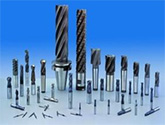The earliest cutting tools were alloy tool steel tools: Alloy tool steel is formed by adding a certain proportion of alloy elements (such as chromium, molybdenum, silicon, etc.) to carbon steel. It has a certain hardness and wear resistance. In the late 18th century, milling cutters, taps, twist drills and other products were introduced.

With the deepening of the industrial revolution, the requirements for cutting speed and efficiency increased. As a result, high-speed steel cutting tools appeared in the late 19th century. Due to their good wear resistance and toughness, high-speed steel cutting tools are currently used in many drill bits.

Following high-speed steel tools, there were carbide tools in the early 20th century. The emergence of carbide tools marked a new era of tool materials. Carbide tools are made of carbide powders of refractory metals (such as tungsten and titanium). It is mixed and pressed with a binder (such as cobalt or nickel) and sintered at high temperature. It has extremely high hardness and wear resistance. It can process both non-metallic materials and ferrous metal materials. It is also a mainstream tool on the market.

Ceramic cutting tools were developed after carbide cutting tools. The time difference is not much. Ceramic cutting tools are harder than carbide cutting tools. They are mainly used in cast iron, hard steel, high temperature alloy and other fields. However, because of their high brittleness, they are generally not recommended. Due to intermittent cutting conditions, it only has obvious advantages in certain subdivisions and has not been well developed.

Later, with the progress of modern manufacturing industry, more and more materials are difficult to machine. The development of metal cutting technology, especially the emergence of high-speed cutting, dry cutting and turning instead of grinding technology, has put forward increasingly stringent requirements for metal cutting tools. Technical requirements, thus the birth of superhard tools-cubic boron nitride tools and diamond tools

CBN cutting tools and diamond cutting tools are both artificial CBN/PCD cutting tools synthesized under high temperature and pressure using artificial methods. They combine high hardness, high wear resistance, toughness and good chemical stability. Among them, CBN cutting tools Boron tools perform well in high-speed cutting of cast iron, interrupted cutting of hard steel, heavy-duty cutting and other fields. Diamond tools are widely used in the fields of composite materials, graphite, ceramics, aluminum alloys and other non-metallic materials and non-ferrous metal materials.
